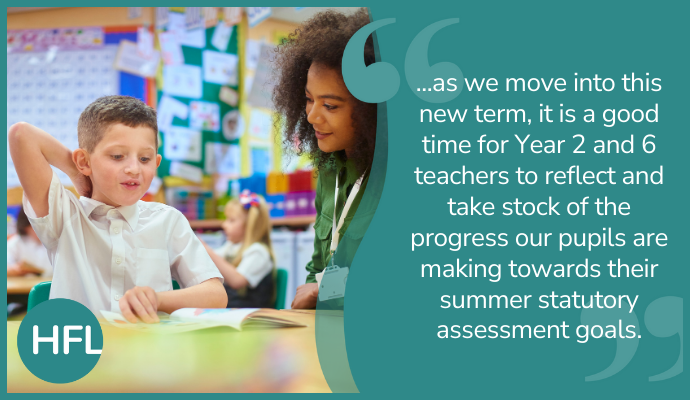
Spring may not be quite sprung yet (or anytime particularly soon), but as we move into this new term, it is a good time for Year 2 and 6 teachers to reflect and take stock of the progress our pupils are making towards their summer statutory assessment goals. That makes it also a good time for Ben and me to cast our mind back to last summer’s moderations and share some of the key observations from successful visits.
Summer 22 saw us brushing off our moderation teams and getting back out into schools for the first time after the pandemic hiatus. It is always a pleasure to spend time looking at the wonderful journeys that pupils have been on, and last year that was additionally so due to the fantastic work that teachers have been doing in helping pupils get back on track and achieve despite the challenges to their learning over the previous two years.
Throughout the 2021/22 year, most of the schools we spoke to were predicting that their percentages of pupils achieving the expected and greater depth standards were likely to be lower than pre-pandemic. All the efforts for catch-up and addressing gaps were fantastic and successful, but with so much missed or not secured, there was a limit to what was achievable in a year when covid was still affecting attendance. For Year 2 pupils, the disruption to their Reception and Year 1 had substantial implications across the curriculum as did the big chunk of Key Stage 2 for our Year 6 pupils. At times it felt as though we all needed to channel our inner Stoic and accept what ‘is’ and where we were, rather than wishing for what could or ‘should’ have been in a world of no lockdowns or absences. It came as no surprise then, that when we collated and looked across the Herts data, the impact of the last few years was clear:

We know that we are advised not to make comparisons between 2019 and 2022 data but we can certainly see the difference that lockdown learning had on our pupils securing their key stage knowledge and skills.
Without wanting to sound overly pessimistic, it is probably realistic to say that the situation is not going to magically be better this year, particularly in Key Stage 2. End of key stage assessment assesses entirely that - the whole key stage - and for our Year 6 pupils, there were two years of disruption and absences whose effects can still be seen. In recent Year 6 writing clusters, we noticed that many of the common issues being raised related to curriculum content from Years 3 and 4 and lingering insecurity with Key Stage 1 content ranging from spellings and punctuation to sentence structure. These gaps in knowledge will have an impact on whether pupils will be able to secure all the ‘pupil can’ statements for WTS and EXS, so tracking back and plugging gaps will need to continue being a feature of Year 6 writing lessons for this year.
We have already gravitated towards writing, so let’s continue by considering some of the good practice we saw at both key stages.
Quantity and quality
Making a secure teacher assessment judgement is so much easier when there is a range of writing to go on. Collections where there was plenty of writing across a range of text types where pupils can show specific skills in a few places were a feature of moderations that went well. Where teachers could see the pupil demonstrating the ‘pupil can’ statements (or not) regularly, they could make more accurate assessment judgements for the cohort.
I am not suggesting this is easy. Many teachers have shared how tricky it has been getting pupils to produce sustained or extended writing over the last year or so. The periods of time where pupils were learning remotely and perhaps not writing as much or at length and certainly without the resources that they have in school have had an impact for many on their writing stamina. It could be that focussing more on building pieces over a couple of lessons rather than in long periods then working on extending the writing could be a method, or indeed including some relatively shorter writing opportunities alongside the longer ones so that pupils can still be demonstrating what they remember and know in different contexts without as much pressure on their stamina. A few Key Stage 1 teachers have shared similar approaches of building some ‘free writing’ time into their day (for example, after lunch) where pupils have notebooks and can write about anything they want or respond to prompts. This unstructured, low-stakes context for writing can be a place where stamina is built but also can be a useful additional insight into where pupils are with their writing. Of course, it is also worth remembering that writing across the curriculum can be included in the teacher assessment judgement, so writing in history books or from science lessons can be a way of expanding the quantity and range of writing available.
Independence
It is also important in that range of writing, that the writing can be said to be independent. I will very quickly say here that we are not taking about ‘cold tasks’ or writing that children have produced without any relevant context or teaching or usual classroom resources. This is especially relevant for Key Stage 1 where the Teacher Assessment Framework (TAF) does say ‘The pupil can, after discussion with the teacher:’ for each of the standards.
For accurate teacher assessment we need to see what a pupil can do without over-direction to be able to say that they have secured a writing skill. As we move through the spring term, we could try to reduce the scaffolding or very directive success criteria or feedback/marking and start to give a little more space for pupils to demonstrate what they can do independently. This is especially necessary if the writing scheme used is quite heavily scaffolded. There are a few approaches to writing out there that end up producing very few independent pieces and it would be useful to perhaps step away from the scheme approach and try to build in some more independent writing opportunities for pupils. Another approach that we saw in some schools to ensure that writing was good for demonstrating a pupil’s skills was where a ‘final’ piece of independent writing was done a week or two after the teaching and shared/modelled writes.
Rather than spend longer talking about independence, I will point you in the direction of an old, but still relevant, blog that explores this.
Feedback
As a development on the above section, it’s worth spending a little time talking about feedback. In schools where pupils had produced a good range of independent work, we often saw that pupils were involved in the editing and improvement process without over-direction from teachers. Earlier in the year, of course teachers were likely to be heavily involved in supporting the editing and improvement process (for example, underlining particular misspelled words), but as the year progressed, we could see them stepping back and allowing pupils to demonstrate their skills more independently. This may be done by the teacher taking a more ‘search and destroy’ approach to pupils finding and correcting errors – a dot or ‘sp’/’punc’ in the margin for a section of writing, as an example – whether that be pupils working alone or with peers to improve their writing. Of course, there is more to editing than just correcting spelling or missing full stops, but this practice was often embedded in a classroom culture of pupils crafting their writing with periods during the writing (mini-plenaries/stop-gaps etc.) or after the writing where pupils can read their work aloud or check for errors to make secretarial or compositional changes to the work.
For Year 2 pupils, in order to achieve the greater depth standard, it is necessary for them to be able to ‘make simple additions, revisions and proof-reading corrections to their own writing’, so not just correcting spellings but also adding to their writing or changing wording to make it better. This ties in nicely with our more general aim to develop our pupils’ metacognitive skills of reviewing/monitoring and developing self-awareness, so hopefully doesn’t feel like it is just something we are doing for the sake of the TAF.
If you are looking to adapt your approach to feedback and how pupils take ownership of their writing, there is another old blog on that here. Marky McMarkface: let’s talk about feedback
Addressing of gaps/pesky habits
As we’ve talked about already, the plague-years have left a mark, and for some of our pupils that mark is that there is curriculum content from earlier years that was not quite secured in the way it would ‘normally’ be and there is then a knock-on effect when pupils are measured against the TAF at the end of key stage.
In the moderations last summer, we had a lot of conversations about how schools had identified and then addressed some of these gaps, misconceptions or ‘bad’ habits that had crept into writing and stayed there. More often than not, it was a juggling act of keeping up with the current year-group curriculum whilst also tracking back to address issues with phonics, or handwriting, or spelling, or sentence construction and so on.
There will remain issues that we will want to address over the year. Are there times when we need to spend a little time exploring the root of a pupil’s tendency and finding that it is a misunderstanding relating to word class or clauses, or perhaps doing a miscue analysis to be able to work systematically through the spelling rules or phonic insecurities to address patterns in spellings. Some of this may be applicable to the whole class, but more often than not, it will be more individualised.
Confidence with TAF inc. qualifiers and what would be a particular weakness
Just a reminder really for teachers to look at the guidance of what Standards and Testing Agency (STA) say about the use of the ‘some’, ‘many’, ‘most’ qualifiers in the TAF. It is really helpful for moderation discussions where there is a consistent understanding of how these would relate to a pupil achieving a ‘pupil can’ statement. As always, the exemplification materials and the collections used for standardisation available through the Primary Assessment Gateway are helpful for illustrating what this looks like in pupil work.
Also worth flagging is how a ‘particular weakness’ may present itself in a pupil’s collection of work. In the preamble to the writing TAF for both Key Stages, the STA outline that at times a particular weakness may mean that particular ‘pupil can’ statements can be discounted to allow for an accurate and appropriate assessment of a pupil. This is for those times where it would be absolutely ridiculous for a pupil to be awarded a lower standard because of one particular tendency or issue but where the rest of their writing is ‘belt and braces’ secure at the higher standard. Of course, this takes professional judgement. If a pupil struggles with coherence, it would be quite the stretch to discount that and say that pupil was meeting the expected standard at Key Stage 1, however, it could be that a child is writing very effectively and ticking everything from the expected standard really securely, but still struggles with some of the spellings of common exception words and can’t be said to be spelling ‘most’ correctly – in this case, the spelling may present a ‘particular weakness’ in their writing and they could still be awarded EXS.
We have yet another old blog that discusses in a little more detail what may be considered a particular weakness. Read A very particular weakness
Moderating in school or at clusters from early in the spring term
I promise this isn’t a shameless plug for our moderation cluster events, but it really was a feature of most of our successful moderations that the class teachers had been involved in moderation throughout the year. This could have been our HFL clusters, but also internally within school or groups of schools that work together. It is just so very helpful, especially in a smaller school where we have less opportunity to look at how another class is doing, to read other Year 2 or 6 pupils’ work and speak to their teachers to standardise the judgements.
Key Stage 1 maths
Moving now to looking specifically at Key Stage 1, there were also some observations that came up for maths.
The maths curriculum is jam-packed. Consequently, the coverage and security required for the TAF meant that it was quite a struggle for teachers to move through everything needed as well as having to spend a lot of time in the autumn term plugging gaps and tracking back to address issues that had arisen from the covid times. Hopefully that is less of an issue this year for our current Year 2s but getting everything covered in time for the end of June statutory assessment deadline is always a challenge.
I never like the idea of the TAF being a tail that wags the dog, but it is sensible to cross-reference teaching sequences with the ‘pupil can’ statements to check coverage and what needs to go where. The spring term is a good time to audit if there are any things that look like they may be an issue and then rejigging where possible to give pupils a chance to learn and then apply their knowledge.
In schools where moderations went really well, they had done this and really thought about how they could gather independent application evidence throughout the year. Sometimes, the gathering of independent application was in the form of starters or plenaries that were retrieval practice of content from previous weeks or months, or in the form of a daily practice activity that again, allowed pupils to demonstrate their security outside of direct teaching. As a small caveat to this, if these activities are in an early morning maths session or similar, please do keep an eye on those pupils who may often be late and miss these. It is always frustrating where regular absence means a lack of retrieval practice and thus, evidence, for a pupil.
Collecting evidence can be low impact on teaching. What I mean by that is that it doesn’t necessarily call for teachers to be completing special TAF tests for maths or similar, but rather, that through the sort of day-to-day/regular formative/low stakes assessment , you can gather quite a lot of quality independent evidence throughout the year. That could be via morning maths, fluency sessions, integrated cross-topic activities or regular retrieval practice (the last lesson/last month/last term type activities we often talk about for formative assessment), hinge questions and so on.
As always, please do get in touch if you have any questions regarding assessment: hfl.assessment@hfleducation.org






